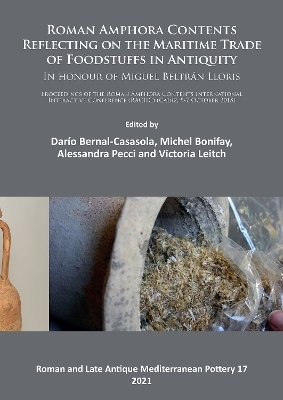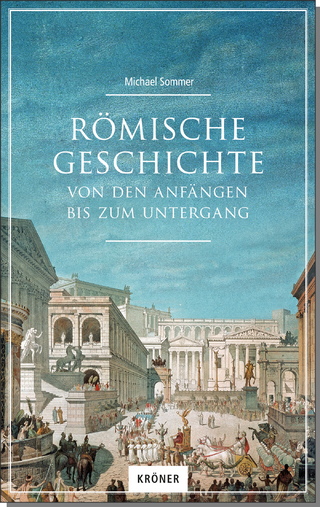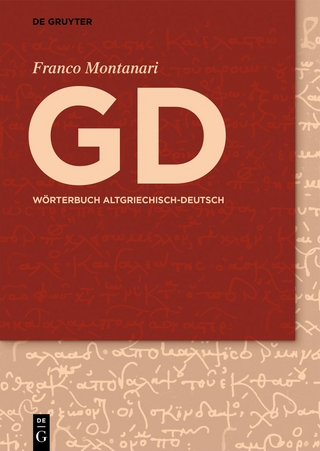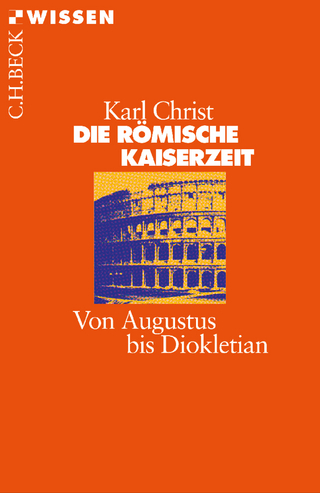
Roman Amphora Contents: Reflecting on the Maritime Trade of Foodstuffs in Antiquity (In honour of Miguel Beltrán Lloris)
Archaeopress Archaeology (Verlag)
978-1-80327-062-3 (ISBN)
Roman Amphora Contents: Reflecting on the Maritime Trade of Foodstuffs in Antiquity gathers together the results of the RACIIC International Congress (Roman Amphora Contents International Interactive Conference, Cádiz, 2015), dedicated to the distinguished Spanish amphorologist Miguel Beltrán Lloris. The aim is to reflect on the current state of knowledge about the palaeocontents of Roman amphorae. With over 30 specialists from different countries, the text examines four elements diachronically throughout the Roman period up to the 7th century, with some insights on pre-Roman times: 1) the intimate relationships between amphorae and their contents, from an interdisciplinary perspective (from tituli picti to the evidence from underwater sites, including the problems of reuse); 2) the contribution and current state of knowledge concerning archaeometric approaches (especially organic residue analysis); 3) the evidence at regional / provincial level (from Lusitania to Egypt); and 4) recent case studies, from Corinth, Pompeii and Arles to the Fretum Gaditanum, which allow us to illustrate the different and combined study methods, necessarily interdisciplinary (archaeological, archaeobotanical, archaeozoological, epigraphic, palynological or biomolecular), in order to advance in this transcendental theme and its significance for the economic history and maritime traffic of the Ancient World.
Darío Bernal-Casasola is Professor of Archaeology at the University of Cádiz in Andalusia, Spain, specialising in the Roman Economy and Maritime Archaeology. He studied at Madrid and his main research topics are marine resources exploitation in antiquity and Roman trade. He has directed field projects in Spain, Italy and Morocco. ; Michel Bonifay is Research Director at the Centre Camille Jullian (Aix Marseille Univ, CNRS, CCJ, Aix-en-Provence, France). He is an archaeologist specialising in the classification, production and distribution of Roman African ceramics and their economic significance. He has been involved in field projects in Tunisia, Libya and Algeria. ; Alessandra Pecci is Lecturer in Archaeology, Universitat de Barcelona. She specialises in archaeometry and food practices, mainly through the organic residue analysis of archaeological materials, mortars and plasters. She has participated in international and interdisciplinary projects in Italy, Spain, Turkey and Mexico. ; Victoria Leitch is an Honorary Research Fellow at Durham University and a Research Associate at the Centre Camille Jullian (Aix Marseille Univ, CNRS, CCJ, Aix-en-Provence, France), specialising in Roman African/Libyan ceramics. She is Publications Manager at the Society for Libyan Studies and Editor of Libyan Studies.
Preface ;
Ánforas romanas y contenidos. Notas historiográficas – Miguel Beltrán Lloris ;
Historical and archaeological indicators ;
Amphorae: typology and contents – Stefanie Martin‑Kilcher and André Tchernia ;
Shipwrecks, amphorae and contents – Franca Cibecchini ;
Amphora contents as commodities: the structure and function oftituli picti in the western Mediterranean in the 1st century AD – Enrique García Vargas ;
How late antique dipinti contribute to a better knowledge of amphora contents – Jean-Luc Fournet ;
The reuse of transport amphorae as packaging containersin the Roman world: an overview – J. Theodore Peña ;
Archaeometric indicators: generalities and case studies ;
Amphorae and residue analysis: content of amphorae and organic coatings – Nicolas Garnier and Alessandra Pecci ;
GC-MS analysis of pitch from Roman amphorae from Cosa in Etruria (Italy) – Hitomi Fujii, Carole Mathe, Fabienne Olmer and Cathy Vieillescazes ;
Residue analysis by GC-MS and FT-IR Spectroscopy on Roman amphorae from the archaeological site ‘Nuovo Mercato Testaccio’ (Rome) – Florinda Notarstefano and Mariateresa Lettieri ;
The contents of ancient Graeco-Italic amphorae.First analyses on the amphorae of the Filicudi F andSecca di Capistello wrecks (Aeolian Islands, Sicily) – Nicolas Garnier and Gloria Olcese ;
Inland trade and consumption in context. A case study on the organic residue analysis of transport amphorae from the Balkan Peninsula (Yambol District, South-eastern Bulgaria) – Silvia Polla, Andreas Springer, Birte Gruber, Petra Tušlová and Barbora Weissová ;
The Beirut amphora: residue analysis and contents – Marshall Woodworth and Paul Reynolds ;
Making Garum. Experimental archaeology methods – Álvaro Rodríguez-Alcántara, Ana Roldán-Gómez, Enrique García Vargas, Darío Bernal-Casasola and Víctor Manuel Palacios-Macías ;
Regional and provincial syntheses ;
West ;
Lusitanian Amphora Contents – Inês Vaz Pinto, Rui Morais, Carlos Fabião, César Oliveira and Sónia Gabriel ;
The Iberian and Roman amphorae of Hispania Citerior – Ramón Járrega Domínguez and Albert Ribera i Lacomba ;
Amphora contents in Baetica: from thePunic tradition to Late Roman times – Darío Bernal-Casasola, Enrique García Vargas, Antonio M. Sáez Romero and Horacio González Cesteros ;
Tituli picti on Spanish amphorae – Piero Berni and Emmanuel Botte ;
The contents of amphorae produced in Gaul in the Imperial period – Fanette Laubenheimer ;
Italian and Sicilian amphorae and their contents: a general overview – Simonetta Menchelli ;
The content of amphorae from Adriatic Italy – Marie Brigitte Carre and Stefania Pesavento Mattioli ;
African amphora contents: an update – Michel Bonifay ;
Amphorae from the Byzacene coast: what did they contain? – Jihen Nacef† ;
East ;
The oil supply in the Roman East: identifying modes of production, containers and contents in the eastern Empire – Paul Reynolds ;
Feeding the Lower Danube and Pontic areas with local wine and fish products (1st century BC‑3rd century AD) – Andrei Opaiţ ;
Ephesus wines – Tamás Bezeczky† ;
Egyptian amphorae from the Hellenistic to the Late Roman periods – Delphine Dixneuf ;
Case studies: From the West to the East ;
The contents of amphora type T-7.4.3.3 (former type Mañá C2b): ancient problematic and new research perspectives – Max Luaces ;
The fish-salting production centre of Águilas:late-Roman amphora content analysis – Alejandro Quevedo, Myriam Sternberg and Juan de Dios Hernández García ;
New data, new questions on the paleo-contents studies of Roman jars and amphorae in underwater contexts: salsamenta, garum, lymphatum and other fish products – Gaël Piquès, Núria Rovira, Margaux Tillier, Franca Cibecchini, David Djaoui and Carlos De Juan ;
Dressel 21-22 Italic amphorae for fish: the archaeozoological confirmation from the garum shop at Pompeii – Darío Bernal-Casasola, Daniela Cottica, Ricard MarlascaCarmen Gloria Rodríguez Santana and Enrique García Vargas ;
Amphorae with residues from Southern Sardinia (Cagliari and Nora) – Ignazio Sanna, Laura Soro and Cristina Nervi ;
‘De profundis’: three amphorae of unorthodox contents retrieved from the Aegean Sea – George Koutsouflakis ;
Salting and consuming fish in the Classical Mediterranean. A review of the archaeological evidence from the Punic Amphora Building (Corinth, Greece) – Antonio M. Sáez Romero and Tatiana Theodoropoulou ;
Conclusion
| Erscheinungsdatum | 06.12.2021 |
|---|---|
| Reihe/Serie | Roman and Late Antique Mediterranean Pottery |
| Zusatzinfo | 175 figures (colour throughout) |
| Verlagsort | Oxford |
| Sprache | englisch |
| Maße | 210 x 297 mm |
| Gewicht | 1930 g |
| Themenwelt | Geisteswissenschaften ► Archäologie |
| Geschichte ► Allgemeine Geschichte ► Altertum / Antike | |
| ISBN-10 | 1-80327-062-4 / 1803270624 |
| ISBN-13 | 978-1-80327-062-3 / 9781803270623 |
| Zustand | Neuware |
| Haben Sie eine Frage zum Produkt? |
aus dem Bereich


